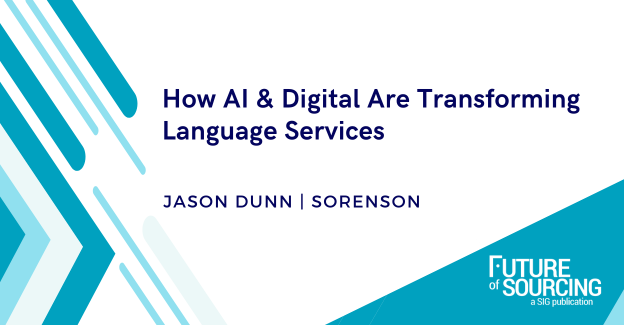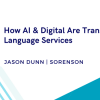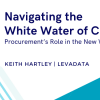Sorenson, a leading language services provider, offers a variety of technology solutions and tools for people with diverse communication needs. These include call captioning, sign language and video services for Deaf and hard-of-hearing people, as well as language translation and interpreting services.
While traditionally focused on consumer markets, the company recognized that demand for its services was growing among enterprise customers. Large businesses, universities and government entities, for example, are increasingly focused on providing accessible and inclusive communication options. Captioning, transcription and video services, moreover, can play a role in post-pandemic workplace models designed to facilitate collaboration among employees in disparate locations.
In addition to transitioning to an enterprise model, Sorenson aimed to extend its services to reach new geographies and populations. This would boost revenues, as well as advance the company’s commitment to providing inclusive and accessible communication services to historically underserved communities. To achieve these objectives, Sorenson would need to transform the company’s existing operational model to enable global reach, rapid response to customer requirements and scalability of scarce skill sets.
Scaling Access to Real-Time Captioning
Communication Access Real-Time Translation (CART) services transcribe words into text or captions as they are spoken during a classroom lecture, business meeting or public speech. For people who are Deaf or hard-of-hearing, who aren’t fluent in English or who have auditory processing disorders, CART services are essential to enable understanding and participation, particularly in higher education. Moreover, CART provides written documentation of an event in real time, and, when combined with signing interpretation, can reinforce learning and information retention for Deaf people.
Traditionally, CART services have required highly skilled stenographers who – in addition to being able to type up to 260 words per minute – were familiar with the arcane medical, legal or scientific terms being used in a university lecture. As a result, an organization’s ability to provide CART services has often been limited by high costs and hard-to-find skill sets.
That is changing, as Artificial Intelligence (AI) and speech recognition capabilities are advancing on several fronts. For one thing, Automated Speech Recognition (ASR) computer software is getting better at understanding accents, jargon and vocal inflections, as well as filtering out background noise. In addition, natural language processing models are deploying deep learning techniques to analyze word clusters and more accurately predict the words that a speaker will use. This is important, since – unlike readily available tools that can accurately transcribe audio recordings after analyzing the entire discussion – CART applications must conduct the contextual analysis on the fly.
Human in the Loop
Despite this progress, AI-enabled automated tools on their own are still not capable of delivering CART services with the accuracy and understanding that many environments require. Sorenson’s CART solution supplements AI-enabled ASR with human intervention, thereby leveraging the respective strengths and capabilities of intelligent tools and human knowledge. Specifically, ASR applies processing speed and contextual analysis to do the bulk of the transcription, while human agents address nuances, ensure the accuracy of technical terminology and correct errors.
The practical impact of this machine/human interface is to significantly reduce the specialized training human captioning agents require, in terms of both stenography (typing speed) and subject matter expertise. As a result, CART services become dramatically more accessible, affordable and scalable. Easier access to CART services, meanwhile, can create new opportunities to improve communication and enhance inclusion for people with unique learning styles.
On-Demand ASL Interpretation
Seamless access to workplace, educational and social collaboration tools is another critical enabler of linguistic and communication inclusion. A Deaf person, for example, can effectively communicate via video conferencing with the support of an American Sign Language (ASL) interpreter. The trouble is, interpreters typically must be scheduled in advance, thereby limiting flexibility and utility.
To address this obstacle, Sorenson recently introduced a first-of-its kind service that allows Deaf users to initiate or join Zoom calls and access an American Sign Language (ASL) interpreter on demand. In terms of workplace and human resources DEI strategies, this functionality has a huge impact for Deaf employees, as it supports inclusion in spur-of-the-moment meetings and facilitates ongoing collaboration with hearing colleagues.
To enable on-demand interpreter scheduling on a wide scale, Sorenson developed a sophisticated Uber-type system that constantly monitors and matches the supply and skill sets of available interpreters against demand for services from Deaf users. The Sorenson platform continues to evolve through the use of AI to predict demand curves, identify potential trouble spots, offer work shifts and measure and monitor quality.
Cloud-Based Globalization
Expanding the scope and reach of Sorenson’s services also necessitated a shift to a flexible and agile cloud-based delivery model – a shift that fundamentally redefined how the company deploys technology. Rather than ordering hardware, waiting for delivery and then sending a team onsite to install, Sorenson now uses code to spin up new infrastructure virtually. This greatly streamlines the implementation and integration of services in new geographies, ranging from isolated counties and communities to new global markets. In addition to providing the scalability needed to cost-effectively support growth, cloud-based delivery provides the flexibility to pivot rapidly should requirements change.
Transitioning to cloud also improved quality of service by enabling deployment of advanced network compression technology. Because ASL involves hard-to-detect subtleties and nuances. Sorenson’s customers rely on clarity and availability of both video and sound that only high-performing platforms can deliver, and that are hard to replicate with on-premise legacy infrastructure.
Cloud migration was accompanied by a redesign of business processes to rationalize orders, billing and invoicing, along with consolidation of call center operations. These changes streamlined a recent expansion into the UK market and position the company to integrate new language services in the future.
For more than 20 years, Sorenson has focused on delivering inclusive language and communication services to diverse communities. Innovation in digital technology is allowing the company to dramatically expand the scope and scale of that mission.
Region:






